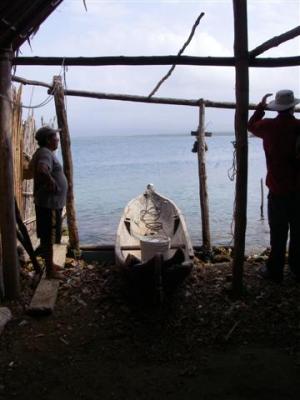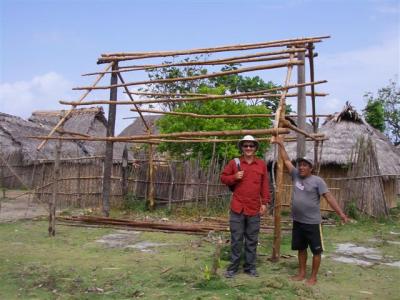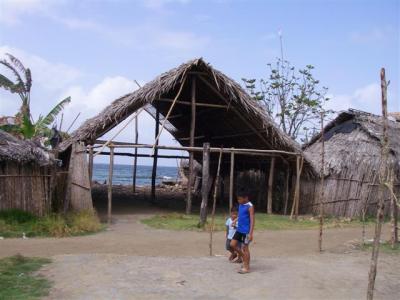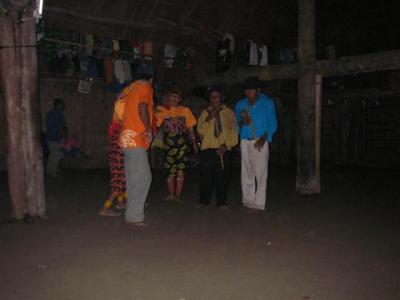Continued from yesterday”¦ After everyone else was served, we were offered the beer. Suddenly, all eyes were on us, intently watching for our reaction. Visually speaking, we would have mistaken it for molasses. It was black and thick, like syrup. They insisted we do the little dance prior to drinking it. Another local joined in to lead us in the dance, which we think we followed along with pretty well. We went to down our beer. It was absolutely disgusting. Mr. G had lied when he said it was non-alcoholic. In those 8 days, it had definitely fermented. It wasn’t a strong alcohol taste, but it was enough to make a gross beverage even grosser. Christi could barely get a small sip down. Eric took one gulp. Everyone insisted we finish our cups. Eric took another sip and said he could drink no more. Everyone was disappointed we wouldn’t drink it, but simultaneously incredibly amused by our reaction. We sat down and held onto our cups for a while people continued to insist we drink it. When it was evident we would drink no more, two guys drank it for us.
We asked where the girl being honored was. Apparently, a special room with a special layout is built for her somewhere, and she is kept in isolation in that room for four days while the whole village holds feasts with drinking and dancing in her honor. The last day of the celebration is her “coming out”. For the coming out, the girl’s head is shaved, her nose is pierced, and her body is painted with berry juice to darken her skin. In this case, the coming out would be in two days.
Then the next part of the ceremony began. Several people walked around the room handing out cigarettes. Several more men were walking around the room passing out shots of gin. We’re not sure how many people there were passing out the gin, but it seemed like every couple of minutes we were saying “no, gracias”. A couple guys were standing in the middle of the room, each holding a gin bottle and shot glasses. People would approach them and do 4 shots of gin in a row. We were kind of shocked at how much alcohol everyone was consuming. The Kuna are tiny people. Many of the women are 4’5″ tall and are literally skin and bones, probably weighing only 80 pounds. These women were doing shots like sailors. The men aren’t much bigger than the women, and these guys were drinking enough to put a 250 lb man in the hospital. Needless to say, everyone was drunk off their butts pretty darn fast.
Basically, the rest of the afternoon we watched them socialize. Everyone seemed to be a happy drunk. No one got violent or started to cry. A few people sang. One guy happily danced by himself. He was wearing a traditional necklace made from pelican bones that made a lot of noise as he danced around. A few women passed out and had to be carried home. Mr. G’s cousin came over and told us over and over how much he loves Mr. G. Most of the people in the room were older, but younger people in their late teens and early twenties wandered in and out. The younger women who were not wearing the traditional attire had on orange tops and black bottoms, so there was some attempt at solidarity. Young kids ran in and out, and Mr. G said they will let even little kids drink if the kids want to.
The room was thick with cigarette smoke. Mr. G asked several times how we liked the culture of his people and we didn’t want to offend him, but honestly, we thought it was somewhat sad. This was the biggest thing that they looked forward to in their lives? Eric was not enjoying it at all and wanted out of there. He asked Christi several times if we could go back to Kosmos. Christi wanted to stick around for the dancing, which started at 1700. Since we were pretty sure the other island was also having a puberty party with similar festivities, Mr. G spoke better English than John, and we had to come back to get Stephanie anyway, it made sense to stay here instead of going back to Cari Suitupo. We agreed to walk around until the dancing started, then go back for the dancing.
Mr. G took us to see his house. It is three huts in a line. The first hut is a mini museum he set up for tourists where we gleaned a little more info than we had gotten from the other museum. The Kuna are a matriarchal society. When a man marries, he leaves his family to live with his new wife’s family and work on the family farm managed by his new father in law. Property rights pass through the female line. We also found out the mola tradition started 500 years ago.
The second hut is the living quarters, which we did not enter. Mr. G lives there with his parents and his mother came out and greeted us and we spoke to her briefly. The third hut is the cooking house. He said that all the Kuna have a separate hut for cooking on their property. They cook the traditional way, on the ground using wood fires. Hmmm”¦ what was all that propane for? Around the room were cooking utensils and dishes.
The back of the cooking hut is almost at the edge of the water. Next to the hut is Mr. G’s dug out canoe, ready to launch at any time. Not a bad view from his property, eh?

Mr. G told us more about the Kuna. Stephanie had said the women marry young and have a lot of kids. Mr. G said that both men and women tend to marry around 15 and have around 12 kids, though that is rapidly changing as more young people are modernizing. The Kuna women traditionally do not use birth control. Given the number of small children running around on all the islands, we don’t think he is exaggerating about the number of kids women tend to have. It sounds like divorce seems to be OK in their society. We found out that homosexuality is perfectly acceptable to the islanders, which surprised us. They think gay people are born that way and don’t see anything abnormal or unnatural about being gay. The Carti islands are the most influenced by modernization because they see the most tourists, and in the outer islands you don’t see as much of a modern influence.
We wandered around the island some more. We saw a couple huts under construction, and Mr. G explained how the construction is done. The frames are branches from cedar and/or mahogany trees. The walls are made of sugar cane, which is a member of the bamboo family. The roof is many, many layers of palm fronds. Vines are used instead of nails and screws. There are no windows. Stephanie had said the huts do well in the wind because the wind blows right through the spaces between the bamboo, and with no wind resistance, the structure is unaffected by the wind. And the ventilation is always good.


We meandered back to the huts on the water next to the hotel. Mr. G told us they are a Mormon church and the concrete building is a school. The school and church share the basketball court. Ah ha! We have seen many Mormon churches around the world and they always have a basketball court. That explains why there is a basketball court here and not on the other islands. The missionary is a girl from Los Angeles, so we wandered in and started talking to her. Mr. G seemed anxious that she was trying to convert us and tried to “save” us from her, but we were filling her in on news at home that she had missed over the last year and a half. The missionaries aren’t allowed any media at all, so she had no clue about the dramatic election and the economic woes our economy is in. He took off and left us to chat, promising to get us when the dancing started.
Apparently, at around 1800 everyone was told to leave the hall. A few women swept up and moved the benches around the edge of the room, with none in the middle. When the room was ready, everyone recon verged in there for dancing. Mr. G came to get us as soon as the break started. We watched them prep the room, then went in and sat down. The dancing began right away. Two men stood in the middle of the room, each holding a wooden flute of sorts and maracas. They drunkenly crooned songs that we could barely hear, and as far as we could tell, they never actually used their instruments. The dancers stood in a circle around the singers. There was a definite leader, who would do assorted steps, and everyone followed what the leader did. Sometimes the leader would walk left or right, sometimes they would grab hands, sometimes they would grab their ears and hop (called the Monkey Dance according to Mr. G) and a few other moves. Everyone was so drunk they could barely stand, let alone walk or dance, so the moves were quite subdued as people focused more on staying upright than dance moves. Christi joined in the dancing for a while. Christi was fairly certain the woman in front of her was going to fall over, so after a few minutes Christi decided to sit back down, fearful of being collateral damage in the inevitable fall. And she did fall over a few minutes later. Here the dancers are next to the musicians.

All in all we stayed for an hour before going to get Stephanie for dinner. We also invited Mr. G. Stephanie says it is good we saw the dancing at the beginning because they just continue to get drunker and the evening at some point will inevitably take a turn for the worse. Mr. G told us that for during puberty parties they are allowed to drink all night, but the any other time of the year they are not allowed to drink past midnight. If caught, they are heavily fined. He didn’t tell us how early they are allowed to start drinking.
Eric navigated us brilliantly through the islands in the dark. We are kind of appalled that most of the sailboats didn’t have an anchor light on, especially because there is a lot of dug out canoe traffic here at night.
Dinner was nice. We learned more about the Kunas and what it is like to live on the islands. For example, the Mormons had offered to put in plumbing and electricity to their island when they built the church, but the chief refused it, wanting to keep things “traditional”. Also, being so low to the water, the island tends to have problems with flooding. Since people cook on the ground using fire and wood, it means they can’t cook at all when the island is flooded, which is obviously a real problem.
We found out that the Kuna don’t value education. While there are schools, no one makes their kids go. Most Kuna cannot read or write. Many do not speak Spanish, just the Kuna language. Mr. G said that even if a Kuna child is educated, there is no hope of ever being a professional like a doctor or a lawyer. The most prestigious job a Kuna can hope for is a teacher because higher education is too cost prohibitive. Mr. G said that the younger generation doesn’t want to farm. They want to make money through tourism and buy food rather than grow it themselves. Mr. G said that as much as the chiefs are trying to fight it, few young people want to carry on in the traditional life style.
After dinner, we took them back. It was scarier going back into the wind and waves, looking for a pitch black island that is low to the ground. We almost got run over a couple of times by speeding dug out canoes zipping by us. We found the pier with no problems and dropped them off. And we also made it back to Kosmos with no problems.

How absolutely fascinating! I guess I am way behind with your blog now, but I did explain in a recent email. Did you get it? Apparently, not all my emails are arriving, so let me know!